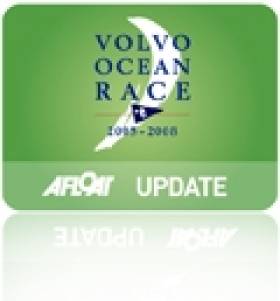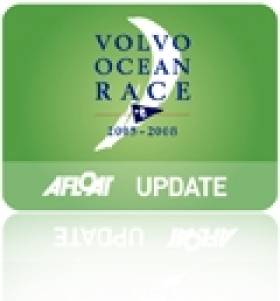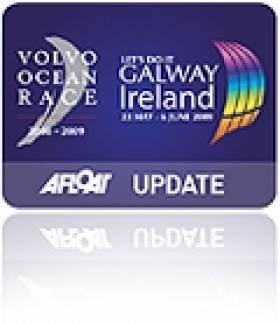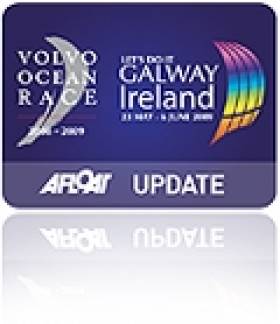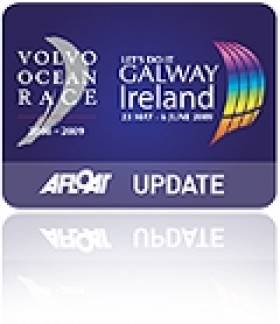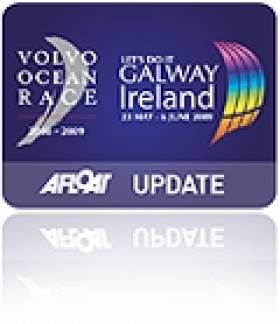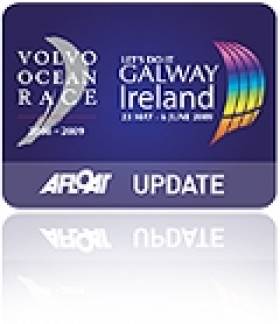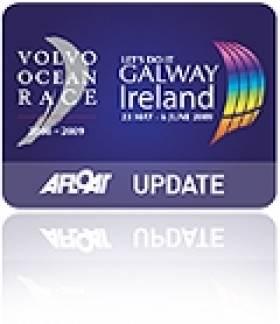Displaying items by tag: Sanya
Chinese Irish Entry Announces Leg One Retirement
Mike Sanderson, CEO/Skipper of Team Sanya, spent time today elaborating on the events at sea on the morning of Sunday 6th November, and the team's intention to get back in the race as quickly as possible,
"We were moving along nicely and very happy with our progress, managing the big breeze and waves very nicely, we were not pushing 100% and had decided to throttle back a knot or so given the conditions; we felt we were in a comfortable zone. I had just had a chat with the guys when we suddenly felt a very odd lurch, like dragging the keel through soft mud. The guys on deck saw a lot of water coming into the bow and we could also hear the noise of water coming into the bow. The watertight doors were already shut thankfully.
We got everyone up and into lifejackets. For sure if the watertight doors had not been shut, we would have been sunk. We avoided the bear away for a time, which was a pretty tense time, we got the pumps going but they were not really making much difference. After a time our situation stabilized, we were nursing the boat upwind at 4-5 knots and then we bore away, got the jib down and suspended sailing as we headed into port.
Initially we had no idea of the extent of the damage, whether it was a small puncture wound or something larger. We could then see some carbon shards coming off the bow, which we realized were the uni directional fibres peeling back and we then realized the severity of the situation. Once we were at the dock in Motril we could see we had a deal breaker on our hands in terms of not being able to carry on racing from here to Cape Town.
With regard to the injury of our bowman, Andy Meiklejohn, he had an unfortunate bad accident in a completely unrelated incident. We were going through a jib change with Andy on the bow in extremely rough conditions and we had reduced speed from 13 down to around 6/7 knots and were nursing her through the waves. We were then hit by a series of massive waves (most likely the same ones that brought down the Abu Dhabi rig). Andy came down badly on his ankle/foot and sustained an injury. We contacted Race Office but were not sure of the breakage at that time. One hour later we were headed for shore due to the bow damage and so thankfully we were able to get him to the local hospital to be assessed where they confirmed he had indeed broken his foot. Andy is now in the process of receiving medical advise and will be treated asap.
Andy is an extremely pivotal team member and will be sorely missed while he is off. We will asses his recovery time and look at our Plan B for a replacement should we need one.
We are now 100% focused on getting the boat to Cape Town as soon as possible that would leave us 8-9 days in Cape Town before the start. Our worst-case scenario is that we ship to Cape Town but then we don't have time to fix it in time so we are late starting from Cape Town and then miss the ship from our stop point during leg 2.
This is no small task, we have a chop out a 6m x 3m x 1m section of the boat and replace it – normally a 2-3 week job shoehorned into 7 days. But this is the Volvo Ocean Race and we will do what we have to do to make it happen.
One fact that gives me some peace is that damage was not caused by anything we did wrong. For sure I have to believe that we hit something that caused the initial puncture wound that then peeled backwards. We were performing well and in good shape, we have not incurred one other bit of damage in those 24 hours so that is good news.
We need to take the time to do some serious thinking and planning, assessing the logistical options and making the right choices that get us back in the race as soon as possible. We need to repair the hull perfectly; a rush job is not an option.
From a personal point of view I have never before retired from a Whitbread or Volvo leg and so it's a pretty sad moment. We were very comfortable with how we were sailing and so it's extremely disappointing for the guys. Looking back on it we wouldn't do anything differently than we did so it's a good feeling that we handled the situation well.
For us as a team, we can still absolutely achieve everything we have set out to do – win some podium positions and take a few scalps from the other teams – and we fully intend to do that still. It is tragic to be out of this leg for sure but perhaps it would have been more tragic for one of the teams focusing on the overall event win.
Accidents do happen and now its all about the tenacity and focus to get it right, we don't give up, we're all dying to get back into the race, it was gut wrenching getting off the boat in Motril and seeing a big part of the boat missing.
Nothing about this team is reckless, we're not quitters or unprofessional in any way, we have a great bunch of guys here and I have absolute confidence that we will get back on the race track as soon as we possibly can. For now it's a full frenzy of activity to get our Sanya Lan race boat on a ship this Friday and turn a boat building job of 2-3 weeks into 7 days!"
Team Sanya will confirm shipping route and dates of departure and arrival into Cape Town as soon as that information is confirmed to them.
Sanya Hull Damage First Photos Here!
#SANYA HULL DAMAGE – Team Sanya crew were driven back to Alicante to the team hotel they have called home for the past few weeks. For most, their families are still here. The damage to the boat is plain for all to see.
Team Sanya are weighing up the different options available to them which include repairing the boat in Spain or shipping her directly to Cape Town and carry out the repairs there. A final decision will be made later today.
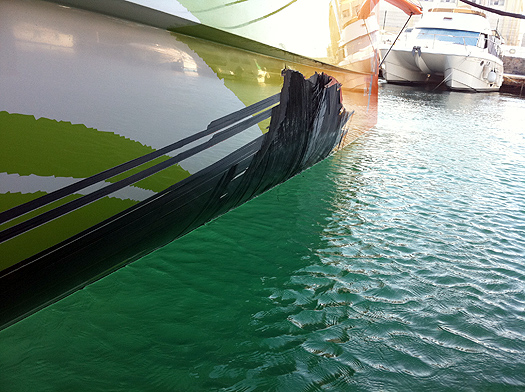
Above and below Sanya's smashed hull - Photo: Team Sanya
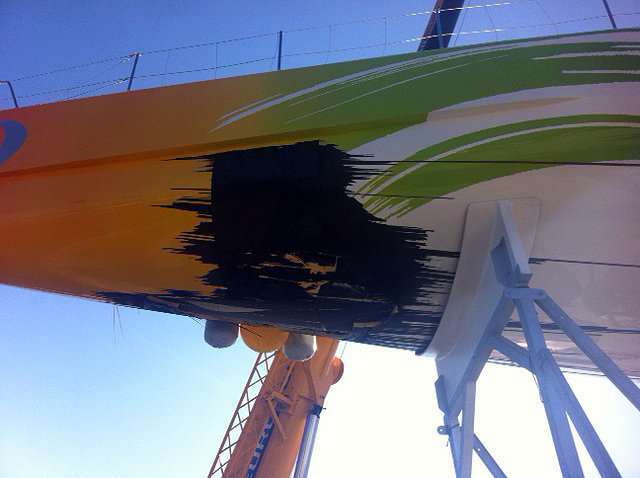
In a completely separate incident during a dramatic sail change yesterday, Team Sanya Bowman Andy Meiklejohn sustained an injury to his foot. He has now had the time to have that injury assessed and the hospital have indeed confirmed that he has broken his foot.
The hope is Andy's foot will have healed and be strong enough to be onboard for the 11th December start of Leg 2.
Discover Ireland Backed Yacht Suffers Hull Damage
#VOLVO OCEAN RACE – 24 hours in to the Volvo Ocean Race (VOR) and the fleet is reduced by one third. First Abu Dhabi was dismasted and now news is coming ashore that Team Sanya has suffered hull damage and is heading back for landfall.
Aksel Magdahl, Navigator on-board Team Sanya reported this morning had suffered hull damage on the first leg of the Volvo Ocean Race 2011-12, which began yesterday in Alicante.
The yacht is 25% backed by Irish tourism body Discover Ireland. The damage happened just 24 hours after Ireland's Minister for the Marine Simon Coveney left the boat shorly after the start of the race.
Mike Sanderson, Skipper has confirmed to Volvo Ocean Race Control that "The situation is very much under control, everyone is obviously disappointed but in good spirits as all are safe on-board," he said.
The boat was approximately 30 nautical miles SE of Motril, on the coast of Spain. The wind was blowing 43 plus knots and the waves were around 10.5 metres.
The watertight doors had already been closed as a precaution due to the prevailing conditions and the boat is making its way to Puerto de Motril. After entering flat water, Team Sanya has suspended racing.
Volvo Ocean Race control is in constant contact with the team while establishing the full extent of the damage so that the crew are given full support to enable them to deal with the situation.
Team Sanya's shore team are working on a recovery plan to ensure the yacht can rejoin the Volvo Ocean Race as soon as practically possible.
1300 hours Sunday: Mike Sanderson, CEO/Skipper of Team Sanya, updates us on the latest situation and his thoughts:So close to making it through the worst of the big breeze and then disaster struck. We were looking after the boat nicely when at approx 0900 this morning while going upwind in 35 knots of wind, suddenly the boat went really bow down and immediately we knew it wasn't good. Instantly we slowed the boat right down, got the remainder of the guys in their bunks into life jackets and then set about tacking over to head for shelter.
The water tight bulkhead is doing a great job, the pumps are running and we are nursing the boat with just a double reefed mainsail into port.
Right now we have no idea how major the damage is, we can however see a puncture wound on the port side and streams of carbon peeling off so it isn't good. We are all safe though, as I write this we are just an hour from a safe harbour. The guys are doing a fantastic job, all very positive and working incredibly hard even though you can see the bitter disappointment on all their faces.
Be under no illusion though, we will be back with vengeance.
I will let you all know as soon as we have checked our poor boat out in a few hours...
New Media Man Announced for Discover Ireland Backed VOR Entry
Team Sanya, the Chinese - Irish backed entry in the 2011/12 Volvo Ocean Race, announced today that Andres Soriano (ESP/USA) is to take on the role of their Media Crew Member.
There has been some disappointment at home given the only Irish crew member on board the boat was Frankie Leonard who withdrew over seasickness in late September. Subsequent applications for the media post included Irish sailors who it now appears were unsuccessful in their quest to join Mike Sanderson on the Sanya boat, 25% funded by Discover Ireland.
Andres started working with Team Sanya as part of the Shore Team back in August 2011 when the team was based in the UK. Since then he has developed a close fit with the team and has gained a detailed understanding of the team objectives as well as the workings of the race boat. These facts, combined with Andres' media background and
experience, puts him in a perfect position to take on this role and deliver great results for the team and the event.
Mike Sanderson, CEO/Skipper for Team Sanya, commented on today's announcement:
" Since day one, Andres has fitted in perfectly with our team spirit and personality. He is an incredibly hard worker and has turned his hand to anything we have thrown at him, which has won him enormous respect from the guys. He has the right balance of media skills and creativity coupled with offshore sailing experience and so I have high hopes for his ability to tell the Team Sanya story to the outside world in a dynamic and unique manner." Andres Soriano, new Media Crew Member for Team Sanya, gave his reaction
to his new role:
"I am truly ecstatic and excited about my role as media crew member. I know it will be one hell of a ride and I consider myself very lucky to be a part of this awesome Team Sanya race crew. We have already built up a keen fan base and I will definitely take on the challenge to expand that by telling our story in an insightful way never seen before."
Andres Soriano Biography details:
Date of Birth : March 26th 1986
Nationality : Spanish American
Resident : Manila, Philippines/New York, USA
Team Sanya Takes Third in Qualifying Race
This qualifier race, which will not see any points awarded, was intended to act as a 'dry run' for the teams and Volvo Ocean Race organization to test safety procedures ahead of the 39,000 nautical mile Volvo Ocean Race, which starts with the Alicante in-port race on October 29th.
The teams experienced the full range of conditions on this short 350 mile trip, from light winds to start with, thunderstorms and 30 knot gusts during the night, to near total becalming towards the end of the race.
Team Sanya, navigated by Aksel Magdahl, took the southerly route around Ibiza on the return leg back to Alicante and was rewarded the best of the breeze, along with Telefonica and Puma. Camper, Groupama and Abu Dhabi Ocean Racing opted for the northern route and suffered from the lack of wind, dropping back despite all of them having been in the lead of the race at some stage.
Telefonica, skippered by Olympic Gold medalist Iker Martinez, crossed the line at 05.45.24 UTC, Puma at 06.48.54 UTC and Team Sanya at 09.15, Camper and Groupama are yet to finish as we issue this report.
Cameron Dunn, Watch Captain on Team Sanya, commented on the highs and lows of this qualifier race,
"We are very pleased with this result, it was a tough and long race with not much sleep for any of us. We made a few errors tactically to start with and then got a few calls right later on but that's all part of the learning curve. It was strange to race without Mike (Sanderson) on board but actually very good for the team and we learnt a lot – we probably made a few more mistakes that we would have made if he had been there, but that's all part of the experience. A good result for Team Sanya."
Aksel Magdahl, Navigator on Team Sanya, explained the tactical challenges as a navigator during the race,
"There was certainly plenty of action and we had every type of condition thrown at us, just like a mini Volvo leg all in 36 hours! We had to make a call on which side to pass the Island of Ibiza and lost out on the way up, initially we gained but then we lost out. We then had a big thunderstorm, massive 30 knot squall and huge shifts so we had a bit of sorting out to do after that, but got going again. The choice to go south of Ibiza on the way back was the right one for sure, we could see the boats to the North parked up and headed south to benefit from better breeze. It was a great experience to do this race, good to shift from practice to race mode."
Finally, Tiger (Teng Jiang He) Grinder/Trimmer, added his views on this qualifier race,
" A very tough race with little sleep. We started with an upwind leg where we must have done around 100 tacks so it was tiring, we had some losses but then overtook Groupama and pushed on forward. The windy night challenged us again with a lot of action on board and finally we finished in no wind. Very exciting and great to be racing."
The Team Sanya race boat is lifted out of the water today, for four days of official measurement ashore.
Sea Sickness Rules Irish Sailor Out of World Race
Galway sailor Frankie Leonard is stepping down as Team Sanya's media crew-member following a bout of seasickness in the recent 2,000-mile qualifying passage for the Volvo Ocean Race (VOR).
The team Sanya entry is a Chinese-Irish entry in the race that starts in November from Alicante. Tourism body Discover Ireland are backing the boat and making up 25% of its estimated €10 milion campaign costs. Leonard was the only Irish crew member on the boat that is under Kiwi skipper Mike Sanderson, a former race winner. The boat, one of seven entries, is expected at the race finish in Gawlay next July.
A statement yesterday described the development as a "cruel blow" to both Leonard and the campaign and paid tribute to the cameraman's commitment and contribution.
Much of the MCM role is dependent on being below decks for extended periods, either working in the tight confines or at the galley preparing the freeze-dried food for the crew and is a mandatory position within every team. The team statement is below.
23rd Sept 2011
Mike Sanderson, Team Sanya CEO and Skipper, announced yesterday with regret a change to the media crew member role following a decision to release Frankie Leonard from his duties. Frankie, who has been engaged with the team since the beginning of the project, unfortunately has suffered from seasickness, which affects a great many sailors.
Mike Sanderson commented:
" Frankie has all of the ideal qualities to fit this role - superb teamwork and communication skills, a dynamic approach to his film and photo work combined with a great sense of humour and a pleasure to be around. However, this race is all about performance on the water and Frankie's suffering from seasickness is a cruel blow both to the team and to him. As anyone who been struck down by seasickness knows well, it can leave you incapable of functioning to your normal levels. We have 37,000 miles of ocean to cover and sadly that left me with no option in this matter.
Frankie has made a great contribution to the team and made many new friends in the time he has been here and we will be keeping in touch for sure."
Frankie Leonard added his thoughts:
"It has been an amazing opportunity to be a part of this special team and a great experience both personally and professionally. I am happy to say that I leave with no regrets. It is always unfortunate when things come to an end but rather than dwell on negatives I prefer to accentuate positives. Team Sanya has had one of the highest media outputs of all the teams with almost double some teams output for video, blogs and photos. We have steadily built up good relationships with the media, our sponsors and Volvo Ocean Race HQ, which can only be a positive for the team. I know that the skills, knowledge and experience I have acquired will stand to me as I now go in search of new projects. I am glad to count Mike and my teammates as good friends now and I wish Team Sanya a safe, happy and fast race."
Dublin to Hamble in 24 Hours - Team Sanya's Video
One minute it's trips round the bay with Miss World, canapés at the Royal Irish Yacht Club and corporate hobnobbing in Dun Laoghaire. The next it's a wet and windy ride from Dublin to Hamble in 24 hours. It's the lot of the modern Volvo Ocean Race crew (helmets compulsory). Chinese-Irish race entry Team Sanya boss Mike Sanderson (a previous race winner) has called his exit from Dublin 'heinous'. Don't take our word for it tho, check his vid below:
SB3 Team Sanya Welcome Scuppered by Strong Winds
Plans for an SB3 flotilla to escort Volvo Ocean Race Chinese entry, Team Sanya in to Dun Laoghaire harbour today were scuppered when winds reached gale force for a time this afternoon.
Regular Dun Laoghaire fleet Sunday racing was to feature the Sanya arrival at 4.30pm but the SB3 club race was cancelled following squalls and torrential rain that also drew a halt to the Star European championship on Dublin Bay.
The Mike Sanderson skippered yacht is berthed alongside the Royal Irish Yacht Club. Team Sanya is a refurbished version of the Telefónica Blue boat from the 2009 race.
The yacht will be engaged with promotional work on Dublin Bay tomorrow with sponsor Discover Ireland.
Rosanna Davison Goes Back to Her Roots Sailing with Team Sanya
Skipper and past race winner Mike Sanderson and his crew - including Galway's Frankie Leonard - will receive a special send-off from Rosanna who won her Miss World title in the Chinese city of Sanya in 2003.
Team Sanya is the Chinese entry in the 2011-12 Volvo Ocean Race, a 40,000-mile round the world race that will finish in Galway on the 3rd July 2012. A special relationship developed between Ireland and China during the last race through the Green Dragon entry, say backers Discover Ireland, the tourism body.
Rosanna will board the yacht at 11.00am at the Royal Irish Yacht Club and will sail with the team into Dublin Port. The Eastlink bridge will lift at 1.00pm, and Team Sanya will dock beside the Cill Airne at 2.00pm. Rosanna will be on the Cill Airne from 5.30-7.00
As part of the team's promotion and it's Irish link through the Discover Ireland.com brand, the race boat and crew will call into Dun Laoghaire on Sunday, 4th September, at 5pm as previously reported on Afloat.ie.
They will overnight in Dublin and sail up the Liffey on Monday at 1pm and dock beside the MV Cill Airne on North Wall Quay, Dublin 1. A reception will be held on the MV Cill Airne from 5-7pm.
At 7pm the Team will head back out into the open sea as they start their journey to Alicante for the race start on the 5th November.
The Volvo Ocean Race is regarded as sailing's premier global race and one of the most demanding team sports in the world. The 2011-2012 Volvo Ocean Race route is: departing on 5th November from Alicante to Cape Town (South Africa) Abu Dhabi (UAE) Sanya (China) Auckland (New Zealand) Itajai (Brazil) Miami (USA) Lisbon (Portugal) Lorient (Framce) and finally Galway on the 3rd July 2012.
Mike Sanderson, skipper and CEO of Team Sanya commented on the forthcoming trip: "Our relationship with Ireland is really important to us. Frankie Leonard from Galway is our media crew member and he is going to be paramount in telling our story as we race around the world, building the profile of Ireland as the stunning tourist destination that it is. For many of our team, it is our first time visiting Ireland so we were really happy to include a pitstop in Dublin during one of our training trips."
Frankie Leonard, Team Sanya race team and the Irish Media Crew Member, added: "As the only Irishman on board I'm very proud to be part of this exciting event with Team Sanya and really looking forward to sailing into Dublin next week. My home town is Galway and finishing there in July 2012 is going to be a very special moment but this stop-over is a perfect way to help build a strong following and fan base in Ireland to develop Ireland's profile as we travel to nine other ports around the world."
Volvo 70 Team Sanya Heading for Dun Laoghaire
The Volvo Ocean Race Chinese entry, Team Sanya, backed by Discover Ireland, is coming to Dublin Bay this Sunday afternoon. She will berth alongside the Royal Irish Yacht Club according to the promoters. At 4pm the Mike Sanderson skippered boat will round a turning mark off Dun Laoghaire harbour before berthing in the port. Team Sanya is a refurbished version of the Telefónica Blue boat from the 2009 race.


























